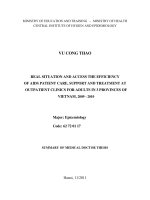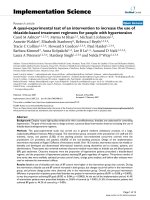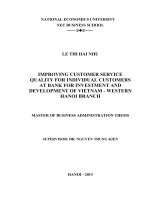INCREASE THE EFFICIENCY OF LENDING ACTIVITIES FOR INDIVIDUAL CUSTOMERS AT TECHCOMBANK KEANGNAM
Bạn đang xem bản rút gọn của tài liệu. Xem và tải ngay bản đầy đủ của tài liệu tại đây (497.94 KB, 80 trang )
DAO MINH NGOC
NATIONAL ECONOMICS UNIVERSITY
CENTRE FOR ADVANCED EDUCATIONAL PROGRAMS
BACHELOR’S THESIS
Major: Finance
FINANCE
Topic
INCREASE THE EFFICIENCY OF LENDING ACTIVITIES FOR
INDIVIDUAL CUSTOMERS AT TECHCOMBANK KEANGNAM
DAO MINH NGOC
2012 - 2016
HANOI, 2016
NATIONAL ECONOMICS UNIVERSITY
CENTRE FOR ADVANCED EDUCATIONAL PROGRAMS
1
BACHELOR’S THESIS
Topic
INCREASE THE EFFICIENCY OF LENDING ACTIVITIES FOR
INDIVIDUAL CUSTOMERS AT TECHCOMBANK KEANGNAM
Student
Major
Class
Student’s ID
Supervisor
: DAO MINH NGOC
: Finance
: Advanced Finance 54B
: 11122808
: TRAN DANG KHAM, PHD.
HANOI, 2016
ACKNOWLEDGEMENTS
I would like to show my gratefulness to all people that have supported willingly to
accomplish the thesis.
First of all, I would like to express my sincere gratitude to PhD. Tran Dang Kham, my
research supervisor, who has given so much instruction, suggestions and encouragement
that did help me to complete this thesis.
2
Futhermore, I am highly appreciated Mr. Hoang Binh Minh and all staff at Techcombank
Keangnam branch for their guidance as well as for providing necessary information
regarding to the report.
Lastly, my thanks and appreciation go to all coordinators and lecturers of Center for
Advanced Educational Programs in giving senior students an internship opportunity to
acquire practical experience and utilize theoretical knowledge.
Thank you,
Dao Minh Ngoc
CONTENTS
3
STATUTORY DECLARATION
I herewith formally declare that I myself have written the submitted Barchelor’sThesis
independently. I did not use any outside support except for the quoted literature and
other sources mentioned at the end of this paper.
Hanoi, 19/05/2016
4
Signature
ABBREVIATION
RBO: Retail Banking Officer
ASO: After sale officier
5
TCB: Techcombank
LIST OF TABLE
6
LIST OF DIAGRAMS
7
INTRODUCTION
1. RATIONALE
Recently, from the reality that when society is growing, not only companies,
businesses need capital to expand production and business markets but also individuals
have the demand for loans and using even more capital. Additionally, intergration and
moderniazaion have brought about higher living standards, which means that many other
8
demands need to be met. Moreover, nowadays individual customer have been used to the
thinking about borrowing money to satisfy their demand for goods prior to solvency. In
order to meet this demand, Techcombank in general and the branch Keangnam in
particular have expanded to provide funds for individual customer needs, which also helps
society solve capital shortage temporarily and make the production process continuous to
advance quality of life. Besides, banks also have an interest-earning account thanks to this
activity to enable the bank to survive and develop. Loans to individual customers not only
brings income to the bank, but also helps the bank diversify risks.
After a period of internship at Techcombank Keangnam branch in position as a retail
banking officer (RBO) and studying the data on the situation of bank lending activity, it is
indicated that lending to individual customers has become one of the basic credit
operations contributing to the bank's revenues. However, the results are less worthy than
what it can be achieved. Lending activities for individual customer loans at the branch still
have some difficulties. Although the amount of individual loan is going up, its growth rate
is not high. Moreover, most of them were gained due to the product that is loan for house
thanks to the cooporation with Vingroup on Gardenia project in 2015, which raises a
challenge for the branch to not only maintain but also improve the result in the following
year. Addtionally, the amount of overdue debts accounted for more than 2%, which is still
a high rate.
In order to resolve these problems as well as develop results, the banks need time to
study and offer solutions to overcome the existing backlog. This is why I choose the theme
"Increasing the efficiency of lending activities for individual customer at Keangnam
Techcombank branch" to do my graduation thesis.
2. RESEARCH OBJECTIVES
• Overview of Techcombank and Keangnam branch.
• Analysis of the current situation of lending operations in general and lending
to individual customers at Techcombank Keangnam.
• Propose some solutions and recommendations contributing to expand the
efficiency of lending activities for individual customers .
3. SCOPE OF RESEARCH
•
Research subject: The problem of personal customer loans.
• Scope of the study : Focus on lending individual customers activities at
Techcombank Keangnam from 2013 to 2015 .
4. RESEARCH METHOD
9
The thesis has used a combination of several different methods such as the method of
dialectical materialism, statistical methods, comparision, evaluation, analyze the
information and data related to financial services serving individual customers at the
branch.
5. RESEARCH STRUCTURE
The research consists of 4 main parts:
Chapter 1: THEORITICAL BACKGROUND
Chapter 2: RESULTS/ ANALYSYS OF DATA
Chapter 3: DISCUSSION AND FINDINGS
Chapter 4: RECOMMENDATIONS
10
CHAPTER 2
THEORITICAL BACKGROUND
2.1.
Overview of commercial banks
2.1.1.
Definition and characteristics of commercial banks
2.1.1.1.
Definition:
First, commercial bank is a financial intermediary organizations implementing
intermediary functions between two or more parties in a certain financial activities.
In other words, the financial intermediary is an organization that supports the
movement of capital between channels lenders and borrowers under the indirect method.
Today, the financial intermediary organizations include: commercial banks, public
organizations and associations, union credit institutions, financial consultants and brokers,
insurance companies, funding, pension funds , commercial banks ... can be defined simply
as business organizations providing products and services to banks for profit.
That is to say commercial banks are kind of financial institution offers a portfolio
of financial services and the most diverse - especially credit, savings and payment services
- and the performance of many financial functions/
2.1.1.2.
Characteristics
First, commercial banking activities are said to mainly pursue for profit.
Specifically, bank performs two activities that are currency trading and banking service. In
particular , monetary operations is expressed in capital mobilization under different forms
to provide credit to customers who demand for capital with the goal of looking for profit.
Moreover, banking services are manifested through available professional knowledge on
currency, payment, foreign exchange, securities in order to undertake to support
customers's requirements accurately to receive either commissions or fee.
Second, it is complusory to comply with the law, which means that as long as
commercial bank fully satisfies the strict conditions, it is allowed to operate in the market.
Third, it is supposed that commercial banking activities have higher risk than other
forms of business and also often has a profound affect on other sectors and the economy.
The reason for this is that monetary operations are conducted by the bank's fundings that
are then used to extend credit to customers on the principle of repaying capitals and
interest for a certain period of time, which could be risky for commercial banking
activities. As a result, not only commercial banks but also customers and the economy
have to suffer from higher hazards. To avoid risks regrettably occur , to control and to
mitigate the damage caused insolvent banks , national governments set up its own laws to
ensure that operations are safe and effective in the market.
2.1.2.
11
2.1.3.
2.1.4.
Roles of commercial banks
In the market economy, the economy has reached a high level of commodity
economy, banks play an important role that is the nervous system, the circulatory system
of the entire national economy. The economy can only grow at high speed if there is a
strong banking system. Banking and the economy has organic relationship to each other.
Therefore , the role of commercial banks is reflected in the following aspects:
• Providing capital to the economy
When comes to the role of commercial banks, it needs to mention the role of providing
capital to meet the needs of production and business entities in the economy. To be able to
carry out production and business activities, the first thing business owners should care
about is capital. Without capital, the enterprise will lose investment opportunities and
profits that could have been obtained .
As a effective distribution channel of funds, banks have to create conditions for enterprises
to have the ability to expand production and improve bank process technology, thereby
improving labor productivity to be able to stand up to the edge increasingly fierce
competition of the market. With the ability to provide capital , banks have become one of
the starting point for the economic development of each country.
• A bridge between enterprises and markets
To have access to output markets and profit-seeking enterprises should pay attention to
their input markets which factors most important input is the capital, this is always a top
concern traders because it puts the first platform for all activities of the enterprise.
Enterprises can not just rely on their own capital which must know how to exploit other
sources of funding for its activities. Credit funds of commercial banks will help businesses
solve the difficulties. Thus, banks are now bridged brought to the market to help
businesses search input, lube production and business activities make it effective in the
best way in the market, help business Industry and markets closer together in terms of both
space and time
• A tool for the state to regulate the macro economy
If the Central Bank is responsible for formulation and implementation of monetary policy
through tools such as open market operations , reserve requirement , interest rates ... the
banks on the one hand directly affected by these tools on the other hand it also participates
indirectly regulating the macro economy through relations with economic organizations
and individuals in the financial and credit activities . In other words , through the operation
of commercial banks with other entities in the economy , all information related to the
monetary policy will be to respond to the central bank , the Bank can help policy makers
macroeconomic appropriate from time to time to ensure the economy to promote growth
and sustainable development .
• A bridge betweem national financial background with international financial
background
The world, in this day and age, every country regularly conducts independent relationships
and complex diversity in many fields: economic, political, social, diplomatic, cultural and
scientific - engineering, ... in which economic relations are often occupied important
positions. Competitive pressures forced the economy of each country after the open
integration potential to grow and comprehensive in all aspects, but the most important is
financial. But how to be able to integrate into the economy of a country with the rest of the
world? This question will be answered through the role of the banking system with a series
12
of non-stop operation is completed and development: international payments, foreign
exchange trading, investment trusts, banks in the system ... countries have local financial
regulator in line with the movement of the international financial system, given the
domestic financial system to keep pace with the international financial system.
2.1.4.1.
Function of commercial banks
• Intermdeiary payment function
Bank as payment intermediary function when it made a payment at the request of
customers as deductions from their deposit accounts to pay for goods and services or enter
money into deposit accounts of customers sales proceeds and other revenues under their
command . The deposit receipt and tracking of revenues and expenses on account of
customer deposits as a prerequisite for the bank acting as an intermediary for payment . On
the other hand , the direct payment of cash between the entities in an economy that is more
limited risk to transport money, the cost of large payments , especially with customers in
creating widely separated should demand for payment through the bank
• Intermediary payment function has important implications for economic activity.
First of all non-cash payments via banks contributed to cost savings and cash flow to
ensure secure payments. Commercial banks will provide customers various forms of
payment, fast and convenient as checks, collection, payment order, payment cards,
electronic payment, clearing, ... allows customers to choose payments which they say is
the most effective and safe. This helps to increase the speed of circulation of goods, capital
rotation speed and efficiency of the process of social reproduction. On the other hand, this
function also contribute to increase the income of the bank through the toll payment
increases the bank's reputation and create conditions for bank deposits to attract funds.
Current currency flows mainly through the commercial banking system so banks are
constantly innovating and improving technology to improve quality to meet the payment
of the customer better
• Function as an intermediary credit
Credit intermediation function is the basic concept of the commercial bank and
the most characteristic and important significance in promoting economic development .
Banks make credit intermediation function when it is " a bridge between capital surplus
and capital shortage " . In other words , after the bank raised the amount of temporarily
idle resources in the economy will form a bank loan funds and will use it to meet the
borrowing requirements of the entities in the background economy which is mainly shortterm loans . With this functionality the bank serves both as the borrower , the lender has .
In other words , the credit operations of banks borrowing banks are to lend
Credit intermediation function derives from the characteristics of capital circulating
currency during the social
reproduction. The reason is not any other organization
in the economy where banks are standing out perform this function because banks are
operating a business organization that monetary and credit, they are full of experience and
the understanding of the situation of demand and supply of credit in the economy so they
can overcome the shortcomings of the financial market that is the mismatch between
demand and supply of credit span of time and the amount that is passed to attract deposits
with a large number of banks can resolve the relationship between supply and demand of
credit in both volume and duration of the loan lender.
Through the intermediary function of credit, banks have contributed to create
benefits for all parties in the relationship is the depositor, the bank and the borrower and
ensure benefits for the economy.
13
• Money creation function
Meanwhile, commercial banks through the intermediary payment function and
credit intermediaries made money carrying on payment deposit accounts of clients in
commercial banks. In other words, by operating on commercial banking system has
created pen replacement for cash currency.
Banks scalability term deposits from an initial deposit, or from funds received
from the Central Bank through the granting of credit to customers are non-bank
institutions. Any bank will be allowed to mobilize deposits and offer term payment
services to customers have the ability to create money. The combination of intermediary
payment function and credit intermediaries to make the system capable of producing
commercial banks deposit payment. From an initial deposit made via credit intermediation
function of banks use to lend, lend the money out to get customers used to buy goods and
services payment while the balance on accounts payment of deposit customers are still
considered part of the transaction amount, which they used to purchase goods and pay
services
..
ie banks created money. And vice versa if the bank raised the amount of capital that banks
are not lending money never created. The creation of money by banks only occurs when
all of the commercial bank operations carried out by bank transfer to the account debited
and credited this to the relevant account.
Performing the function of money creation, with the loans without the appearance
of cash, banks have reduced the volume of cash in circulation, the cost savings, helping to
regulate the money supply appropriate policies price stability, economic growth, reduce
unemployment, increase the total means of payment in the economy to meet the needs of
social payments.
The functions of commercial banks with close relationships, complement and
support each other in which the credit intermediary function is the most basic function,
provide the basis for the implementation of the following functions. At the same time,
when banks implement functions treasurer and payment intermediaries contribute to
increasing credit funds, expand the scope of activities of the bank.
2.1.5. Main services
2.1.5.1.
Fund mobilization
a. It accepts deposits
A commercial bank accepts in the form of current, savings, and the fixed deposits. It
collects the surplus balances of the Individuals, firms and finances the temporary need of
commercial transactions. The first task is, therefore, the collection of the savings of the
public. The bank does this by accepting deposits from its customers. Deposits are the
lifeline of banks.
• Current account deposits:
Such deposits are payable on demand and are, therefore, called demand deposits.
These can be withdrawn by the depositors any number of times depending upon the
balance in the account. The bank does not pay any interest on these deposits but provides
14
cheque facilities. These accounts are generally maintained by businessmen and
industrialists who receive and make business payments of large amount through cheques.
• Fixed deposits (Time deposits)
Fixed deposits have a fixed period of maturity and are referred to as time deposits.
These are deposits for fixed terms, period of time ranging from a few days to a
few
years. There are neither payable on demand nor they enjoy cheque facilities.
They can be withdrawn only after the maturity of the specifed fixed period. They
carry higher rate of interest. They are not treated as a part of money supply.
Recurring deposits in which a regular deposit of an agreed sum made is also a
variant of fixed deposits.
• Savings account deposits
There are deposits whose main objective is to save. Savings account is the most
suitable for individual households. They combine the features of both current account and
fixed deposits. They are payable on demand and also withdrawable by cheque. But bank
gives this facility with some restrictions, a bank may allow four or five cheques in a
month. Interest paid on saving account deposits is less than that of fixed deposit.
b. Equity??
2.1.5.2.
Leasing and investment
a. It gives loans and advances:
The second major activity of commercial banks is to give loans and advances
particularly to businessmen and enterpreneurs and thereby earn interest. This is, in fact, the
main source of income of the bank. A bank keeps a certain portfolio of the deposits with
itself as reserve and lends the balance to the borrowers as loans and advances in the form
of cash credit, demand loans, short-run loans, overdraft.
• Cash credit
An eligible borrower is first sanctioned a credit limit and within that limit, he is
allowed to withdraw a certain amount on a given security. The withdrawing power
depends upon the borrower's current assets, the stock statement of which is submitted by
the borrower to the bank as the basic of security. Interest is charged by the bank on the
drawn or utilised portion of loan.
• Demand loans
A loan which can be recalled on demand is called demand loan. There is no stated
maturity. The entire loan amount is paid in lump sum by crediting it to the loan account of
15
the borrower. Those like security brokes whose credit needs fluctuate generally, take such
loans on personal security and financial assets.
• Short-term loans:
Short-term loans are given against some security as either personal loans to finance
working capital or as priority sector advances. The entire amount is repaid either in one
installment or in a number of installments over the period of loan.
• Investment:
Commercial banks invest their surplus fund in 3 types of securities: government
securities, other approved securities and other securities. Banks earn interest on these
securities.
b. Discounting bills of exchange
Bill of exchange is a negotiable instrument, which is accepted by the debtor, drawn
upon him/her by the creditor and agrees to pay the amount mentioned on maturity.
Discounting bill of exchange is another function of modern commercial bank. Under this,
banks purchase bill of exchange from holder in discount after making some marginal
deduction in the form of commission. The banks pay the deducted value to the holders
when traders discount it into bank.
c.
Overdraft facility
An overdraft is an advance given by allowing a customer keeping current account to
overdraw his current account up to an agreed limit . It is a facility to a depositor for
overdrawing the amount than the balance amount in his account.
2.1.5.3.
Other services
a. Cheque Payment
Banks provide cheque pads to the account holders. Account holders can draw cheque
upon bank to pay money. Banks pay for cheques of customers after formal verification and
official procedures. .
b.
Remittance
Remittance is a system, through which cash fund is transferred from one place to
another. Banks provide the facilities of remittance to the customers and earn some service
charge.
c.
Collection And Payment Of Credit Instruments
In modern business, different types of credit instruments such as bill of exchange,
promissory notes, cheques etc. are used. Banks deal with such instruments. Modern banks
collect and pay different types of credit instruments as the representative of the customers.
d.
Foreign Currency Exchange
16
Banks deal with foreign currencies. As the requirement of customers, banks
exchange foreign currencies with local currencies, which is essential to settle down the
dues in the international trade.
e.
Consultancy
Modern commercial banks are large organizations. They can expand their function to
consultancy business. In this function, banks hire financial, legal and market experts, who
provide advices to customers in regarding investment, industry, trade, income, tax etc.
f. Bank Guarantee
Customers are provided the facility of bank guarantee by modern commercial banks.
When customers have to deposit certain fund in governmental offices or courts for specific
purpose, bank can present itself as the guarantee for the customer, instead of depositing
fund by customers.
2.2. Lending activities in commercial banks
2.2.1.
Definition of lending activities in general
With a history of long-standing and development, banks have played an important
role in the economy . It is a lever for economic development and is an effective tool for the
management of the government . Main activities of commercial bank are to be the
financial intermediary, provide a mean of payment and also be the payment intermediary
which is the most dominant and distinctive one. When depositing money to the bank,
customers can make payment on the account's deposit balances. When bank lending , the
balance increases, customers can use to buy goods and services. Thus lending by banks
has created a means of payment.
To understand the lending activity of bank, it is neccessary to differentiate between
the concept of investment and lending. In broad terms, the loan is a credit operation and is
one of the investment activity. Specifically, it is a transaction between the people who
have money to lend and the one who need to borrow. The money is obviously allocated for
a certain amount on condition that the principal and interest paid by the deadlines given.
While, an investment is an asset or item that is purchased with the hope that it will
generate income or appreciate in the future. However, both lending and invesment of
commercial banks have their own features. Lending activity is operating directly with
customers through negotiation while in investing activities, the banks themselves choose a
variety of portfolio securities with fixed maturities. Besides, the initiator is customers who
have demand for loans in lending activity while it is the bank that will actively initiate in
invesment activity.
According to Article 3 of the decision 1627/2001 / QD - NHNN, " Loans are a form
of credit, under which credit institutions delivered to customers an amount of money used
for certain purpose and given time under the agreement with the principle of repayment of
principal and interest." Lending activity of banks including loans , guarantees, financial
leasing , commercial bills discounted . Lending is a basic form of credit operations. Bank
17
provides money directly or through assigned account to customers. After completing
process, it is compulsory for borrowers to use the loan for the certain purpose. According
to the signed contract the bank must provide enough money for customers and timely
regulation, and therefore customers should ensure payment of principal and interest to the
bank on time.
Customers want to borrow money from any bank must also meet the conditions
prescribed by law . First customer must have civil legal capacity , civil act capacity and
responsibility under civil law, which helps the bank to be able to select good customers
and also be proteced by law in case customers do not follow the contract properly.
Morever, the purpose of loans must also be legal, which means that the borrowers cannot
lend money to run business that sells forbidden goods. Therefore, there should be
investment projects, business plans for production and services that are effective and
accurate with the provisions of law.
2.2.2. Classification
Lending is a frequen activity in commercial bank. Althought it contains many risks, it
brings most of profit for banks. In banking activities an amount of capital are delivered to
customers under the purpose of either consumers or business production . After a certain
period of time, customers have to pay principal and interest to the bank. Lending activity is
also divided into several categories.
-
Based on the purpose
+ Loans for industrial and commercial business.
+ Loans for individual consumers.
+ Loans for selling real estate.
+ Loans for agriculture.
+ Loans for the real estate business.
-
Based on the loan term
+ Short-term loans: loans with term of up to 1 year. The purpose of this type is
usually to finance the investments in liquid assets.
+ Medium-term loans: loans with term of 1 to 5 years. The purpose is usually to
finance investments in fixed assets.
+ Long-term loans: loans with term of more than 5 years. The purpose is usually
to finance the investment in the project.
-
Based on the level of customers's confidence, credit activities can be divided into
the following categories:
18
+ Loans unsecured: the kind of loans without collateral, pledge or guarantee of
others based solely on the customers's trust to lending decisions.
+ Loans guaranteed: the types of loans based on the loan amount as security for the
mortgage, pledge or guarantee from a third party other.
-
Based on the method of lending
+ Short-term loans for production and business is the type that when borrowing,
customers and institution intermediaries have to follow requiring procedures and sign the
credit contract.
+ Loans under the credit line: the type of lending that credit institutions and banks
identify and agree a credit line to maintain in a certain time period.
+ Loans under overdraft limit: credit institutions have written agreement allowing
customers to use the amount of money that exceeds more than what customers already
have.
-
Based on the origin of the credit
+ Direct Loans: banks directly provide funding to people who have demand, and
the borrowers also directly repay the loans to the bank.
+ Indirect Loans: Loans are being made through the acquisition of the agreements
or documents and other debt incurred in the billing period as: trade discount.
2.3. Lending activities for individual customers
2.3.1. Definition and characteristics of lending activities for individual customers.
2.3.1.1. Definition
Lending is the traditional activities of the commercial banks and also the most
important activity. Loans accounted for the highest proportion of total assets, generated the
largest interest income but also the most risky activities. Lending is a form of credit,
which banks delivered to customers using an amount to be used for the specified purpose
and time as agreed with the principle of repayment of principal and interest.
Customers having demand for loans include businesses and economic organizations,
individuals and households, which plays an increasingly important role in the operation of
lending in commercial banks. Individuals and households normally borrow money from
banks to cater to consumer demand or serving investment activities, its production and
business.
Thus, personal customer lending at banks consists of the form of loans that banks
provide to individuals or households for the purpose of consumption, investment and
production business.
2.3.1.2.
Characteristics
19
-
Objects: individuals and households demand for loans used for consumer purposes
or activities serving production. Apart from enterprises and economic organizations
, individual customers often have a very large amount and loan demand is also very
diverse. However, their demands are not always frequent and affected by the
economic environment, culture and society.
-
Duration of the loan : Depending on the loan purpose and form of loans that the
loans of private clients with a term : short, medium to long term.
-
The size and number of loans: the size of individual loans is usually smaller than
that of corporate loans. However, the number of loans providing to individuals are
often large. Moreover, commercial banks's oriented activity is retail banking ,
therefore the total size of the individual customer loans usually account for a huge
part of the total loan.
-
Borrowing costs : because individual loans usually have small-scale, the amount of
these loans are usually very large, banks often have to spend a lot of costs (both in
terms of manpower and tools) in the development of client relatiomship , appraisal ,
approval and management of loans. Therefore , the fees charged on this type of loan
is often greater than enterprise loans.
-
Lending rates: The interest rate on these loans is usually higher than other loans of
commercial banks. The reason is that the cost of lending is large and loans have a
high degree of risk. As a result, its rates generally is from 1.2 to 1. 5 times higher
than corporates's lending rate in Vietnam.
-
Credit Risk : Individual loans are usually the most risky for banks. This happen due
to customers's financial situations depending on the job status and their health that
often changes. Additionally, In production and business activities, individuals and
families often have weak management skills, lack of experience, backward
technical and scientific level, and also limited competitiveness in the market. Thus,
banks will have to face many risks when the borrower is unemployed, goes
bankrupt....
2.3.2.
Assessment of the efficiency of lending to individual customers
2.3.2.1. Definition
Efficiency of lending to individual clients is one of the manifestations of economic
efficiency. It reflects the quality of the lending activities of banks. Moreover, it is lending
capacity that is suitable with developing requirements of the economic and social's
objectives and customer needs to ensure the principle of repayment to be on time,
profitable for banks. On that basis, ensuring the survival and sustainable development of
the bank .
2.3.2.2. Indicators assessing the efficiency of lending to individual customers
20
a. Loan growth rate (%)
(Credit loan at year t - Credit loan at year t-1)
Loan growth rate (%) = ------------------------------------------------- x 100%
Credit loan at year t-1
This index is used to compare the growth of credit outstanding through the year to
evaluate the possibility of lending , finding customers and reviews the implementing plan
of the bank credit.
The higher the index, the more stable and efficient level of activity of bank,
whereas banks are struggling, especially in finding customers and demonstrate that the
performance of the credit plan has not been effective .
b. The growth rate of lending business (%)
(Loan sale at year t - Loan sale at year t-1)
The growth rate (%) = ----------------------------------------------------x100%
Loan sale at year t-1
This indicator is used to compare credit growth through the year to assess the
ability to borrow, find customers and reviews the implement plan of the bank credit.
Moreover, it includes the entire loan portfolio in the current year to date and the loan
portfolio during the year has been recovered.
The higher the index, the more stable and efficient level of activity of bank,
whereas banks are struggling, especially in finding customers and demonstrate that the
performance of the credit plan has not been effective .
c. The growth in the proportion
Individual loan amount
The growth in the proportion (%) = --------------------------------------x100%
Total loan amount
This indicator reflects how much percentage individual loans account
for in the lending activities of banks. Higher index demonstrates that
individual lending activities plays an increasingly important role in the
business operations of the bank .
21
d. The ratio of overdue debts(%)
Overdue debts
The ratio of overdue debts( % ) = --------------------------------------- x 100
Total loan amount
This indicator shows the situation of overdue debts at the bank , while
reflecting the credit management of the bank lending rebounded , urging the banks
to recover debts for loans .
These are indicators used to assess the credit quality and credit risk at banks
The higher percentage of delinquency represents that credit quality of banks
is falling , and vice versa .
e. Number of customers
This indicator reflects the number of bank customers through the period ,
showing the ability to attract customers of the bank in recent years .
2.3.3. Factors influencing lending activities for individual customers.
2.3.3.1. Internal factors
a. The size of commercial banks.
The size of banks is assessed by indicators: Equity capital, total capital (total
assets) and transaction network.
Owner's equity is one of the most important criteria when evaluating the
capacity of a commercial bank, the greater the equity capital demonstrates the
potential of the stronger banks, the more favorable conditions in developing
business activities, particularly development of credit business. In addtion, large
equity capital will be easy to build the headquarters, procurement of modern
equipment, capable of covering the broad market and create an advantage over the
competitors. Otherwise, small banks with little capital size will focus on the
development of consumer loans for the meager amount of charter capital, which
means that they will not compete with the big banks to lend large loans.
The own capital of the bank shall ensure Cook coefficient (the ratio of
minimum own capital adequacy over total risk assets was 8%). As a result, when
expanding business activities and assets of the bank banks have increased, their own
capital will need to increase respectively. Expansion and development of consumer
loans need to take into account its own capital to ensure capital adequacy ratio
minimum. Therefore, if banks want to develop consumer lending, they have to
always focus on increasing their own capital.
Scale of total equity ( or total assets ) of banks expresses their calable of
lending in general and lending to personal customers in particular. With large
-scale capital, banks will be able to lend large amounts to meet the many needs of
the customer loans, the bank will generate a list of products and services for various
loans.
Commercial banks having a wide network of branches and transaction will
have favorable conditions to access customers especially individuuals. With its
extensive network, banks not only easily raise capital, implement lending products
but also are reached without difficulty by customers when needed.
b. Lending organization for individual customers
Organizing lending activities of commercial banks has a huge impact on
lending results and the capability of expanding loans. Lending operations are
usually implemented through many different stages: product design, promotion,
marketing, guidance documents, evaluation and credit analysis, monitoring and debt
collection. Besides, different bank has different way in arranging its activities.
Some commercial banks do not consider lending organization as a seperated one
but just a part of lending activities in general. In contrast, nowadays, many
commercial banks pay so much attention to loans for personal customers that they
are professionally held. Specifically, each department is in charge of each stage,
which has helped to improve and expand lending activities.
c.
Marketing Activities
Marketing activities are to introduce, promote and build the image of the bank
as well as the products and services that the bank offers. It is also important
activities contributing to the expansion of lending activity. Thanks to marketing
activities, customers can learn about banking products and banking services
provided. If done well, they will bring more customers to the bank and lending
operations.
d.
Quality of staff
Lending operations is complex and consists of several stages. In addition to
the help of the equipment and technology, the human factor is considered to be very
important, which decides the success or failure of lending activity. If a bank wants
to individual lending activities, it should have professional skilled staffs, with
professional ethics in all stages including product research and development,
marketing, evaluation and classification credit, management and debt collection.
The focus on developing human resources in the stages of loans guarantees that
banks can get the appropriate loan products and meet the diverse needs of the
customer. It also helps the process to be completed quickly, safely.
e.
The level of technology and management
In banking activities , technology and management skills play an important
role, banks are always the organizations that get the most advanced technology and
modern management skills in the economy. Specificlly, banking technology is the
software and hardware of the device information used in the bank. Thanks to
modern technology such as computers, ATMs, systems management program
enables banks to simplify procedures and shorten the time of transaction, and also
secure information for our customers. Additionlly, management level is shown in
the management, inspection and control the activities of the bank. The better
management capabilities will enable banks to operate efficiently and achieve profit
goals.
When proposing development strategy for borrowing, it is neccessry to
consider its technology and management level, which will bring about either
favorable or difficult for the bank. If banks have high level of technology and
management, it will be a factor in promoting the development of individual loan,
which help shorten the time lending to each individual, prestige, trust to customers,
thereby increasing loan sales and profits. When proposing the strategy, banks need
to reassess the level of technology and its management compared with competing
banks and the level of development of banking technology in the world. Banks must
develop technology and improve management capacity to be able to win in the
markets to bring more profits.
2.3.3.2.
External factors
a. Economic environment
Economic environment greatly affect personal lending activity of the banks in
general and lending activities in particular. Its impact is positive effect, which
means that when economies develops, the lending activity is also extended. In
contrast, when loans are reduced, the economy goes into recession or in difficult
times.
As the economy grows, people's incomes rise stably, the living standards of
the population improve so that consumer demand, expanding business production
increases, which create favorable conditions for activities for expanding lending. As
the economy downturn, production and business activity are shrinking, consumer
demand of the population also decreases due to the concerns about declining
earnings outlook of people in the future. This makes lending negatively affected.
Inflation and interest rates in the lending market are also factors affecting the
expansion of lending by commercial banks. When interest rates rise in the market,
the cost of borrowing for the purpose of serving consumers or business increased
production is the cause of this limited loan demand. Likewise, when the economy is
high inflation, goods become more expensive. Moreover, the higher cost of
consumer activity, real income of population decrease lead to reduce consumer
demand, and operations business also shrunk, negatively impact the expansion of
lending by commercial banks.
In terms of commercial banks, while the economy recession risk in lending
activity increasing, commercial banks implemented measures to limit risks:
tightening of lending conditions, managing close loans, strengthening monitoring,
collecting debt, which limits expansion of individual lending.
b. Cultural environment - society
Cultural and social environment has significantly affect on individual
customers lending at commercial banks. The impact of socio-cultural environment
can be a positive effect - stimulating the growth or negative impact - reducing the
development of personal lending operation. A number of social and cultural factors
having impact include: demographic factors, consumer habits, educational level,
customary...
Large size population, young population and high income is an ideal
environment for the development of loan in commercial banks. However, factors
that literacy levels and consumer habits are important factors affecting the









